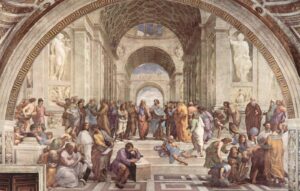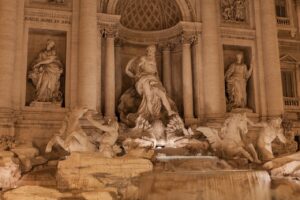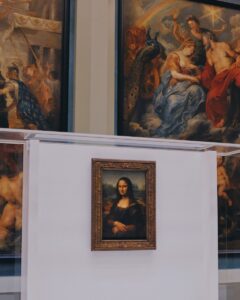Imagine stepping back in time to a world where art not only reflected beauty but also sparked a cultural revolution. This was the Renaissance, a period from the 14th to the 17th century that marked a pivotal moment in European history. Originating in Italy, Renaissance art introduced a fresh perspective on the artistic expressions of classical antiquity, transforming them with a blend of Northern European styles and the latest scientific knowledge.
As you explore Renaissance art, you’ll discover how it wasn’t just about creating aesthetically pleasing works; it was a harmonious blend of philosophy, literature, music, and science. This era didn’t just influence artists and their patrons—it revolutionized the way the Western world viewed art and its role in society. Dive into the rich tapestry of Renaissance art and experience the dawn of the Early Modern age, where every painting and sculpture holds a story waiting to be told.
Historical Overview of Renaissance Art
The Rise of the Renaissance: Key Factors and Context
The emergence of the Renaissance, spanning the 14th century, marked a pivotal return to classical antiquity, fostering an environment where art transcended simple visual aesthetics. This era, born in Italy, magnified the importance of humanism—a concept that placed human thought, beauty, and the study of classical antiquity at the heart of its practices. The advent of humanism played a crucial role, influencing artists to explore new subjects beyond the traditional ecclesiastical themes. As a result, both secular art and religious paintings flourished, showcasing a richer, more diverse range of narratives from the natural world, mythology, and everyday life.
Economic prosperity and political stability in regions like Florence also contributed significantly. These elements provided a fertile ground for the arts by ensuring patronage from affluent families such as the Medici, fervent supporters of classical learning and the arts. Moreover, technological advancements, like the development of oil painting technique in Northern Italy, allowed for more expressive and detailed artistic expressions, greatly admired in both northern Renaissance art and Italian Renaissance works.
Major Periods in Renaissance Art
Renaissance art can be broadly categorized into three main periods: Early Renaissance, High Renaissance, and Northern Renaissance. Each period demonstrates distinct characteristics and notable contributions by prominent artists.
- Early Renaissance (Late 14th to Early 15th Century): This period laid the groundwork for the Renaissance art movement. In cities like Florence, artists like Lorenzo Ghiberti and Masaccio began experimenting with perspective, bringing a three-dimensional feel to flat images. Their work depicted not only religious scenes but also elements of the natural world and classical antiquity, setting a precedent for future Renaissance artists.
- High Renaissance (Early 16th Century): Often esteemed as the zenith of Renaissance art, the High Renaissance emphasized classical harmony and balance. It’s during this time that giants like Leonardo da Vinci, Michelangelo, and Raphael produced some of their most renowned works, such as the frescos in the Sistine Chapel and ‘The School of Athens’ by Raphael. These artists advanced the techniques of their predecessors, achieving an even greater naturalism in their works.
- Northern Renaissance (Late 15th Century Onwards): While the Italian Renaissance thrived, the Northern Renaissance blossomed independently across parts of France, Germany, and the Netherlands. This movement extended the Renaissance spirit beyond Italy, adapting its ideals with a regional twist that often included more emphasis on domestic interiors and landscapes. Artists like Albrecht Dürer and Jan van Eyck made significant innovations in oil painting and detailed, realistic portrayals of daily life, reflecting the social and cultural contexts of Northern Europe.
Key Characteristics of Renaissance Art
Renaissance art, a pivotal movement from the 14th to the 16th centuries, marked a profound cultural transformation across Europe. It reintroduced classical learning and sophisticated artistic techniques, focusing on humanism and the natural world.
Innovations in Painting Techniques
The Renaissance period saw significant advancements in painting, dramatically enhancing how artists depicted light, texture, and the human form. The introduction of oil painting allowed for greater detail and vibrancy in colors, as seen in works by renaissance painters like Leonardo da Vinci and Michelangelo. Techniques such as chiaroscuro, used to achieve a full range of light and shadow, and sfumato, a method for softening transitions between colors, contributed to the lifelike quality of Renaissance art. These innovations allowed High Renaissance artists to create depth and realism that drew the viewer into each scene, revolutionizing the approach to pictorial art.
Sculpture and its Evolution
During the Renaissance, sculpture transcended the Gothic style, harkening back to the ideals of classical antiquity. Italian Renaissance sculptor Donatello pioneered methods that would dominate Renaissance sculpture, such as the contrapposto stance, where figures were depicted in a dynamic human pose that suggested movement. Michelangelo further developed this technique, his David being a prime example, which demonstrated an extraordinary understanding of human anatomy and an embodied classical spirit. These changes marked a shift from the rigid, static figures of the Middle Ages to sculptures that communicated flesh-and-blood realism and emotional intensity.
Architecture: A Revival of Classical Ideals
Renaissance architecture was marked by a resurgence of ancient Roman styles, including the use of domes, columns, and arches that symbolized harmony and balance. Filippo Brunelleschi’s design of the Florence Cathedral dome exemplifies the innovative use of engineering techniques and geometric principles from classical antiquity. This period also saw the construction of the Sistine Chapel, famed for its fresco ceiling by Michelangelo, which combines architectural mastery with extraordinary artistic expression. The use of symmetry and proportion in Renaissance buildings demonstrated a reverence for the classical past and influenced architectural practices in Western art well into the contemporary world.
Iconic Artists and Masterpieces
The Renaissance heralded a profound revival in the arts led by iconic figures whose innovations laid the groundwork for modern western art. This period showcased a definitive shift from medieval to early modern Europe, where art embraced realism, humanism, and classical learning.
Leonardo da Vinci and His Contributions
Leonardo da Vinci, emblematic of the Italian Renaissance, mastered the art of subtle gradations in tone and color, enhancing the realism and depth of his paintings. Known for masterpieces like “The Mona Lisa” and “The Last Supper,” Leonardo’s meticulous attention to human anatomy and the natural world set new standards for artistic excellence. His sketches of human bodies, derived from dissections, coupled with innovative techniques such as sfumato, allowed him to create the smoky, gradient effects that became his trademark. Leonardo’s impact on Renaissance art extends beyond painting, as he also delved into scientific investigations and mechanical designs, embodying the Renaissance man ideal.
Michelangelo’s Impact on Sculpture and Painting
Michelangelo, distinguished as both a sculptor and painter, was pivotal in defining the High Renaissance style. His sculptures, like “David” and “Pieta,” showcase an unparalleled understanding of the human body and emotion, capturing both the physicality and the spirituality of his subjects. In painting, Michelangelo’s frescoes on the Sistine Chapel ceiling, particularly “The Creation of Adam,” are monumental for their dynamic composition and intricate human figures, reflecting his mastery of the human form and religious themes. His ability to portray complex human expressions and interactions elevated narrative realism in art.
Raphael and the Development of Frescoes
Raphael, renowned for his clarity of form and ease of composition, was instrumental in pushing the boundaries of fresco painting during the Renaissance. His works in the Vatican’s Stanze rooms, especially “The School of Athens,” exemplify the ideal of High Renaissance art with their balanced compositions, harmonious colors, and classical spirit. Raphael’s frescoes are celebrated for their visual achievement and depiction of the intellectual ferment of the period, often featuring figures inspired by classical antiquity alongside contemporary Renaissance scholars. His techniques in perspective and anatomy continued to influence the visual arts long after his era, bridging the gap between the art of the early Renaissance and the advancements of the High Renaissance.
Renaissance Art Across Europe
Renaissance art marks a pivotal moment in the cultural history of Europe, transcending geographical boundaries and influencing various regions with its innovative approaches to visual arts. This transformative period breathed new life into the appreciation of classical antiquity and paved the way for future artistic endeavors.
Differences in Italian and Northern Renaissance Art
Italian Renaissance art, fostered in the heart of cities like Florence and Rome, focused prominently on classical learning, human anatomy, and linear perspective. Artists like Leonardo da Vinci and Michelangelo revolutionized the art scene by introducing techniques that emphasized the human body and detailed, lifelike representation in their work. High Renaissance painters in Italy prioritized harmony, proportion, and a deep engagement with classical antiquity. Works such as Michelangelo’s frescoes on the Sistine Chapel ceiling exemplify the High Renaissance style that dominated Italian art.
In contrast, Northern Renaissance art, primarily flourishing in areas like Belgium and the Netherlands, differed markedly from its Italian counterpart by integrating a high level of detail and a strong emphasis on daily life and naturalism. Northern European artists utilized oil painting techniques to achieve precision and subtlety in color gradations, leading to vivid textures and intricate expressions of the natural world. While Italian artists were inspired by classical antiquity, those in the North drew inspiration from medieval art, focusing on meticulous realism and complex plays of light and shadow in subjects ranging from religious themes to secular art.
Renaissance Influence in France, Germany, and Beyond
The ripple of Renaissance art and ideas extended well beyond Italy, deeply influencing the cultural tapestry of France and Germany. In France, the introduction of Renaissance art led to a splendid amalgamation of Italian techniques with local artistic traditions. French Renaissance artists embraced the oil painting technique, which allowed for greater flexibility in layering and detail, thus enriching the visual arts with textures previously unseen in fresco painting.
Germany witnessed a unique interpretation of Renaissance influence as well. Artisans and craftsmen combined the technical advancements of the era with the Gothic style prevalent before the Renaissance, creating a distinct fusion that emphasized both classical spirit and the decorative arts. In both regions, art historians note the period was marked by a robust exchange of ideas due to increased travel and communication, with patrons and artists alike eager to harness the artistic innovations born during the Renaissance era in Italy.
Through these explorations, the Renaissance proved not only to be a revival of classical learning but also a pan-European movement that set the stage for the modern age, demonstrating the wide-reaching impact of Italian masters and their Northern contemporaries.
The Legacy of Renaissance Art
The Renaissance era, spanning from the 14th to the 17th centuries, marked a profound transformation in the art world. This period fostered a resurgence of classical learning and artistic ideals, which continue to influence art and culture globally.
Influence on Later Art Movements
Renaissance art decisively shaped subsequent Western art movements. The techniques and stylistic innovations developed during the Renaissance laid the groundwork for high Renaissance artists like Michelangelo and Leonardo da Vinci. These figures introduced principles of classical harmony, the depiction of the human body, and the exploration of human anatomy in their works, which profoundly influenced the Baroque art that followed. The transition from medieval, two-dimensional art to Renaissance emphasis on three-dimensionality and realistic space in paintings was revolutionary. Art historians recognize the High Renaissance as a catalyst that ushered in the modern era of European art, blending classical antiquity with newly developed techniques such as oil painting. This mastery is observed in iconic frescoes like the Sistine Chapel ceiling and in Leonardo’s fresco painting, “The Last Supper.”
Renaissance Art in Modern Collections
Today, Renaissance artworks are treasured highlights in major collections and continue to attract millions to galleries worldwide, such as the Uffizi Gallery in Florence. This gallery, among others, houses an extensive collection of Italian Renaissance art, including both secular art and religious paintings. Modern audiences can explore the versatility of Renaissance artists who excelled across diverse media—from classical paintings to decorative arts. Moreover, institutions like the Louvre in Paris preserve and exhibit Italian Renaissance masterpieces such as Da Vinci’s “Mona Lisa,” connecting contemporary viewers with the Renaissance spirit. These collections not only celebrate the artistic achievements of the Renaissance period but also reflect on the cultural and intellectual revival that defined the era, allowing the legacy of Renaissance art to endure in the visual arts landscape.
Wrap-Up
Renaissance art isn’t just a chapter in history books—it’s a living legacy that continues to enchant and influence. As you’ve explored the intricate dance between Italian elegance and Northern detail, the enduring impact of these masterpieces is unmistakable. From the majestic halls of the Uffizi Gallery to the iconic Louvre, the journey of Renaissance art is a testament to its timeless appeal. Whether you’re an art aficionado or a casual observer the rich tapestry of Renaissance art offers endless insights and inspiration. Embrace the beauty and the lessons of this pivotal era and see how it continues to shape our artistic expressions and cultural conversations today.
Other suggested articles:
Eloquent Communication: The Power of Gracious Conversations
Wine Tasting Etiquette: Guidelines for the Discerning Connoisseur
Intelligent Home Systems: Smart Solutions for Modern Luxury Living



